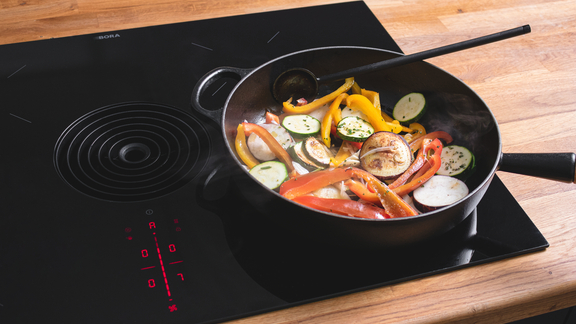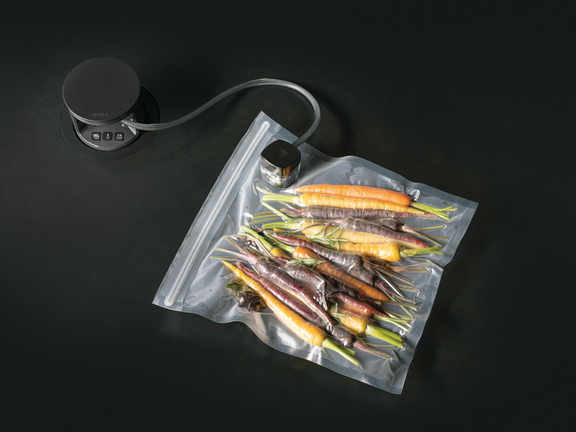

What's left over after dinner can be cleverly prepared:
Utilising leftover food not only saves resources, it's also a great way to try out new, creative recipes. For example, you can turn leftovers from a festive roast into a colourful stir-fry with crunchy vegetables, or turn potatoes and rice into crispy pancakes in no time at all. The way you store leftovers also plays an important role when it comes to utilising them. Storing cooked food safely extends its shelf life and you can use it to conjure up a delicious dish a day or two later. We show you what can be made from leftovers and how they last longer.
931 million tonnes: That's how much food ends up as waste worldwide every year. This corresponds to around 17% of global food production. In Europe alone, the average amount of food and products thrown away per capita is 113 kg. Valuable resources are lost: Cultivation and transport require large amounts of water, energy, land and labour.

It is often not necessary to dispose of leftovers. Thoughtful stockpiling and using up leftovers minimises waste, saves money and expands the menu. All you need are creative ideas for delicious leftover recipes and a few helpers.
Tip:
To counteract food waste in general, it is important to make sure when shopping that you only take home what you actually need. Meal plans can help here. The recycling of leftovers can be considered at the same time. This means that less ends up in the rubbish bin - which is good for sustainability and your wallet.
Were your eyes bigger than your stomach or did the festive feast turn out to be very sumptuous? You don't need to throw away leftover meat and vegetables, because you can conjure up many a culinary highlight from them - and in no time at all. Utilising leftovers not only saves resources and money, but also a lot of time. Looking for ideas?
Countless culinary delights can also be created from classic leftovers. Pasta can be turned into a quick lunch with colourful vegetables and egg, mashed potatoes can be made into croquettes, rice can be made into pancakes with leftover vegetables and egg.
Whether fresh or dry produce, cooked or raw food: proper storage is crucial to safely utilise leftover food. If processing is planned for the following day, it is usually sufficient to keep them in the fridge. This also applies to many fresh products. But be careful: Not everything that comes straight from the supermarket is in the right place. Tomatoes, bananas and oranges do not belong in the fridge. For longer freshness, it's worth knowing how to store food safely in the fridge.
Can't process it the next day? Many leftovers can be frozen. This applies to cooked meat, most vegetables, sauces, stocks and cheese, for example.

Important: Raw potatoes do not belong in the freezer. They can become mushy and take on a sweet flavour. You should also use up eggs in good time. Raw eggs run the risk of bursting because the liquid expands in the cold. Cooked eggs take on a rubbery consistency.
What shouldn't go in the freezer should go in the storage cupboard: Store opened packs of pasta, oatmeal or flour as well as opened spices and herbs in a dry and dark place in the cupboard. Tip: Put leftover food in storage tins or preserving jars. This will prevent food moths and the leftovers will keep for longer.
As a general rule:
Creativity knows no bounds. Dry toast or rolls can be combined with sugar, eggs and milk to make poor knights of Windsor. Raw or cooked leftover veg can be whipped into a creamy soup in a jiffy. Wilted lettuce or spinach can be blended with fruit to make a green smoothie.
Try using leftover food in different ways: to make innovative recipes, mix together ingredients that at first glance don’t go together. For instance, apple and strong cheese make a great team. You can create a summery salad with leftover melon and feta.
Freezing, canning, vacuum sealing, drying: there are many ways to preserve food. Fruit and vegetables can be canned and meat and fish can be vacuum sealed. Virtually all foods keep considerably longer after a few hours in an automatic dryer or in the oven on a low heat.
From leaves to cores, (almost) everything is edible: that’s the idea behind the food upcycling trend. For instance, kohlrabi, cauliflower and celeriac leaves are all edible, as are mango, orange, lemon and kiwi peel or melon and papaya seeds. But be careful: if you want to eat or reuse the peel, it’s best to opt for organic varieties.